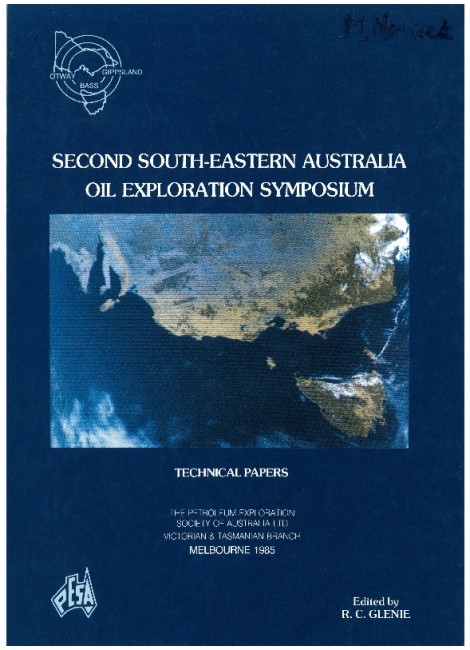Publication Name: Second South-Eastern Australia Oil Exploration Symposium - Technical Papers
Authors: J.M. Bodard, V.J. Wall and R.A. Kanen
Date Published: December 1986
Number of Pages: 38
Reference Type: Book Section
Abstract:
Sediments making up the Upper Cretaceous-Eocene Latrobe Group in the offshore part of the Gippsland Basin comprise a thick amalgamated sequence of arenites, siltstones, variably carbonaceous mudstones, common coal beds and minor volcanics. The nature, associations, stratigraphic and temporal relationships between wireline log facies have been used to differentiate the Latrobe Group into Upper-Latrobe, Southeastern Top-Latrobe, and Lower-Latrobe parts. Distinct lithofacies associations (the Bonita, Stonefish, Snapper and Trevally Sandstones and the BasalLatrobe) within these major divisions are defined.Whereas the Upper-Latrobe consists of regionally persistent interbedded sands and shale/coal, the underlying mid-Upper Paleocene and older LowerLatrobe successions comprise coarse sandy facies near the continental margins of the basin and thick shaley strata elsewhere. The lithic content of typically coarse mid-Campanian and older Lower-Latrobe strata is comparatively high, and younger Lower-Latrobe successions in southerly areas are generally made up of variable sandstone and shale ? coal mixtures. Southeastern Top-Latrobe strata consist of thick multiplestacked sandy facies in the eastern and southeastern parts of the basin. These form a northeast-southwest striking linear trend older than the Upper-Latrobe. Southeastern Top-Latrobe sandstones both pinchout in shaley Lower-Latrobe strata to the west, and overlie similar Lower-Latrobe successions in the east and southeast.
The Upper-Latrobe is interpreted to be a result of extensive shoreline migration which distributed sandstones of coastal barrier origin over low-lying otherwise well vegetated coastal plain environments. Low- to high-sinuosity luvial, coastal plain, back barrier and locally deltaic environments, laterally related over a broad region, comprise the LowerLatrobe successions. Southeastern Top-Latrobe deposits are attributed to sand-rich coastal barrier and minor shallow marine environments introduced from the southeast. Associated with development of the Tasman Sea, the Latrobe Group was deposited during three major stages in punctuated, westerly transgressive coastal onlap over eastern Victoria:
Inland Alluvial Valley: Cenomanian to Campanian sand- and coal-poor siltstone and mudstone sequences succeed to sand-dominated alluvial/fluvial clastics toward the basin's margins, and are focussed in the northeast (Tuna), and northwest through to southwestern (Wirrah, Seahorse, Barracouta, Tarwhine, Bream) regions. Structurally controlled by major eastwest trending fault systems, the early history of the Latrobe Group is characterised by stream plain, and localised lacustrine deposition, in the north-central (i.e. Snapper, Turrum, (?)Marlin, Veilfin) to northeasterly (Flounder) parts of the basin. At higher depositional gradients along the basin's continental margins, alluvial fan/braided stream environments persisted in which Basal-Latrobe and Snapper Sandstone strata were deposited. Predominantly dip-fed, these depositional systems characterised a narrow,
east-west aligned inland alluvial/fluvial valley situation exhibiting laterally complex lithofacies associations.
Aggradational Coastal Plain and Barrier: Latest Campanian deposits in the east to Maastrichtian Lower Paleocene sediments basinwide are characterised by high, less laterally variable sand/shale ratios, marking the first major westerly migration of coastal barrier/strandplain depositional systems across the basin. The subsequent establishment of these (and associated) largely strike-fed systems in the southeast brought about a broad, low relief coastal plain environment regionally. Alluvial/fluvial systems in the Tarwhine, Barracouta (the Barracouta Formation) and Wirrah areas continued to feed sands basinward and the vertical up-building of strandplain sandstones delimited an extensive central region of lagoons and marshes traversed by minor streams. During this tectonically stable stage, mud-rich coastal plain environments became more laterally extensive and increasingly vegetated. Occasional short-lived transgressive- regressive pulses deposited sands at various times and to variable extents over the coastal plain environment, reflecting fluctuations in the Paleocene eustatic/tectonic balance. Several sand-dominated facies associations, including the Bonita, Stonefish and Trevally Sandstones, are recognizable over large parts of the basin within aggradational stage facies associations. These are interpreted to comprise westerly extensions of amalgamated coastal barrier sandstones. The basin broadened and in the east the depositional trends became aligned northeast to southwest.
Mixed Coastal Plain and Coastal Barrier: The locus of sand accumulation spread basinwide owing to multiple
transgressive-regressive events and to resulting regional shoreline migration during the latest Paleocene
to Eocene. Coal swamps of the flat-lying coastal environment were periodically drowned during this
eustatically sensitive stage. Submarine channeling, which incised interbedded sandstone/coal-mudstone
Upper-Latrobe (and deeper) sequences in the Tuna, Marlin, and Flounder areas, reflected the occasional
establishment of marine continental shelf conditions. Local deposition of a thin, glauconitic, fine sand, silt
and mudstone unit (the Gurnard Formation) ended the Latrobe depositional event in association with the
regional onset of shallow marine conditions.
Despite its long history of exploration, the Gippsland Basin still offers substantial scope for the discovery of
additional petroleum reserves.


